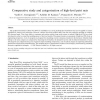Free Online Productivity Tools
i2Speak
i2Symbol
i2OCR
iTex2Img
iWeb2Print
iWeb2Shot
i2Type
iPdf2Split
iPdf2Merge
i2Bopomofo
i2Arabic
i2Style
i2Image
i2PDF
iLatex2Rtf
Sci2ools
JSS
1998
1998
Comparative study and categorization of high-level petri nets
The graphical formalism of Petri Nets (PNs) is established on a strong mathematical foundation that can be applied in systems speci®cation, analysis and veri®cation. However, classical (low-level) models suer from the state explosion problem as resulting PNs become larger. Thus, their ability to represent and analyze realistic large scale systems is reduced. High-level PNs have been introduced in order to extend the modeling power of low-level models. This paper presents an assessment of high-level PNs from an engineering perspective. A set of categories is proposed for classifying several extensions presented in the literature. Models which belong to the same category are compared by discussing the formalism, the descriptive power and the inherent limitations of each. All categories are compared using a set of general criteria including compactness, ease of analysis, degree of supporting re®nement/ ion and specifying communication. The modeling power of representative models of ...
| Added | 22 Dec 2010 |
| Updated | 22 Dec 2010 |
| Type | Journal |
| Year | 1998 |
| Where | JSS |
| Authors | Vasilis C. Gerogiannis, Achilles Kameas, Panayiotis E. Pintelas |
Comments (0)

